Hacker Perspective: SiriusXM Satellite Radio (info for techies)
- If you live in a large urban community comprised of more than a million people, then you are most likely being served by a TERRESTRIAL REPEATER. This means that 90% of the information below will be of little use to you.
- You do not need to know this stuff to use or enjoy your satellite radio. Continuing the "shortwave enthusiast" and "ham radio" traditions of yesteryear, this web page contains information targeted toward people wishing to investigate further. (Nerds + Technophiles)
- Many people use the phrase Sirius XM Pandora, but no such company exists. Sirius XM Holdings Inc. purchased Pandora Media (deal closed 2019-Feb) then managed it as a wholly-owned subdivision.
In his 1992 non-fiction book on telecommunications titled "How the World Was One" (a play on words), author Arthur C. Clarke wrote: since radio signals from above could not be jammed by repressive regimes and governments (as often happened previously), that satellite radio technology would help promote democracy throughout the world.
Clarke didn't mention "the internet" (1969) or the world wide web (1991) or social media (YouTube in 2005, Twitter in 2006 or Facebook in 2007) but I am certain he would have found it of little value for telling spreading democracy. This is especially since the US government (under both Biden and Trump) has leaned on social media platforms to block channels or contributors that the US government didn't like. But since some countries today are actively filtering internet content closer to the client end, satellite radio is still one preferred method for learning the truth.
Satellite radio aside, North American democracy is in decline partly due to suppression of "public broadcasters" like NPR (radio: 99% defunded by the US congress in 2011) and PBS (television: 90% defunded by the US congress in 2011) which have resulted in a greater number of uninformed and misinformed American citizens. Meanwhile, business interests in England (beginning with Rupert Murdoch) managed to reduce much government funding for the BBC so now both BBC America and BBC World Service pay their bills with commercial advertising (not sure about the BBC Home Service which only serves Great Britain). Similarly, the Canadian government partly defunded the CBC in 2015.
Oops! Trump v2.0 and his Republican majority just (2025) removed all government funding of NPR and PBS. The Corporation for Public Broadcasting (created by an act of congress in 1967) is no more. This means that both NPR and PBS can only survive via public donations.
It should go without saying that it costs a lot of money to run high power radio transmitters, so it makes sense that CBC, NPR, and BBC distribute their programming content through many channels including satellite radio. In 2025 I noticed that all three were publishing their programs to YouTube which is a good thing for anyone with a stable internet connection (the internet over WiFi in your car might not count)
Since late 2005, the only factual news comes to me from international sources on my Sirius satellite radio. I think about Arthur C. Clarke every morning when I press the power button.
update: in May of 2025, the Trump administration called for to

SiriusXM Links:
Canadian Links:
- www.siriusxm.ca (over 2.5 million subscribers as of 2025-01-01)
- Canadian snowbirds can now listen to CBC and BBC anywhere in the USA. Mexico and Caribbean.
- Optional Accessories from Canadian Sources.
- www.amazon.ca
- www.bestbuy.ca (lots of radios and accessories but no premium antenna kits)
- www.eBay.ca (eBay Canada)
- satellite-radio-source.ca (premium antenna kits, radios, docking kits; Mississauga, Ontario)
- Sirius Satellite Radio - Repeater Map (Canadian cities visible on Northern US States)
once there: click the PLUS sign to "zoom in" then left-click-hold your mouse to drag the map.
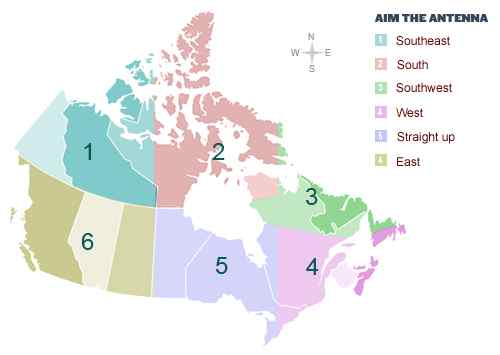
American Links:
- www.siriusxm.com (over 33 million subscribers as of 2025-03-31)
- www.DogstarRadio.com - content info.
- Sirius Satellite Radio - Repeater Map
once there: click the PLUS sign to "zoom in" then left-click-hold your mouse to drag the map.
- Sirius Satellite Radio - Repeater Map
- www.DogstarRadio.com - content info.
- Optional Accessories from USA Sources.
- www.tss-radio.com - previously known as: TheSiriusStore.com
- www.myRadioStore.com
- www.eBay.com

Satellite Technology
- How Satellite Radio Works @HowStuffWorks
- Sirius vs. XM @HowStuffWorks
- Geosynchronous Orbit @Wikipedia (then search "elliptical")
- Analemma @Wikipedia (Analemma = looping)
- Satellite engineering - Sirius orbital path
- https://space.skyrocket.de/doc_sdat/sxm-7.htm (updated: 2025-06-07)
- https://en.wikipedia.org/wiki/Sirius_XM#Satellites (usually up to date)
- Sirius + XM satellite database.
- https://www.n2yo.com/satellites/?c=33 (use this when heavens-above is offline)
- Table data from satellite database hosted here: https://www.heavens-above.com
Satellite Orbit Launch Altitude (km) Notes SIRIUS-1 Analemma 2000 24,772.5 - 24,794.7 defunct SIRIUS-2 Analemma 2000
defunct SIRIUS-3 Analemma 2000
defunct SIRIUS-5 FM Geostationary 2009
SIRIUS-6 FM Geostationary 2013
XM-1 Geostationary 2001 36,120.6 - 36,181.6 deorbited XM-2 Geostationary 2001
deorbited XM-3 Geostationary 2005
in orbit spare XM-4 Geostationary 2006
deorbited
XM-5 Geostationary 2010
SIRIUSXM-7 Geostationary 2020
SXM-8 Geostationary 2021
SIRIUS XM-9 Geostationary 2024
SXM-10 Geostationary 2025
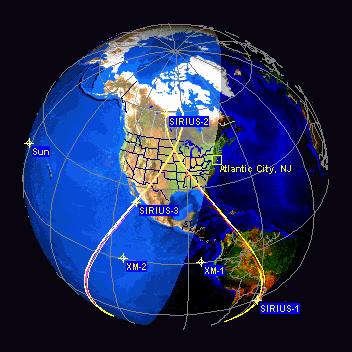
- Maxar Delivers High-Power Digital Audio Radio Satellite to Launch Base for SiriusXM
- https://www.space.com/spacex-sirius-xm-sxm-7-launch-rocket-landing-success (2020-12-13)
- https://www.space.com/sirius-xm-7-satellite-fails-in-orbit (2021-01-28)
- https://thedesk.net/2021/03/sxm-satellite-total-loss-sxm-7-maxar/ (now declared a total loss)
- https://www.space.com/spacex-sirius-xm-sxm-8-rocket-launch-landing-success (2021-06-21)
- https://en.wikipedia.org/wiki/Sirius_XM#Satellites
- https://spacenews.com/siriusxm-orders-pair-of-satellites-to-expand-in-canada-and-alaska/
(2022-11-29)
note: this page also contains forward looking data about two launches in 2026 + 2027
- SpaceX launches Sirius XM radio satellite to orbit, lands rocket on ship at sea (video, photos) (2025-06-07)
STARMATE-1 "Home Installation" Notes:
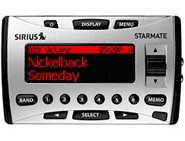
- The following notes refer to my new (2006) STARMATE-1 ST1C (a Canadian version of ST1).
- The SIGNAL STRENGTH meter did not work until after service activation (this is fixed in subsequent models)
- Push the MENU button, then push DOWN ARROW button four times to the SIGNAL INDICATOR item then push SELECT
- SAT - displays satellite signal strength
- TER - displays terrestrial repeater signal strength
- Only present in densely populated cities like Toronto, Montreal, New York, Los Angeles, etc.
- Originally provided as an alternate signal source for vehicles driving between very tall buildings, under bridges, or through tunnels.
- Your antenna does not require a view of the sky in Toronto because the terrestrial repeater is on top of the C. N. Tower
- nerd alert: this display is a special purpose florescent tube (not a solid-state technology like LED or LCD)
- Push the MENU button, then push DOWN ARROW button four times to the SIGNAL INDICATOR item then push SELECT
- As is true with all satellite equipment, antenna placement is very important. The antenna should have an unobstructed line-of-sight path to the satellite:
- I started off using the Sirius Indoor-Outdoor Antenna (also known as Folding Windowsill Antenna) from the home-docking kit.
Sirius documentation tells people in Southern Ontario to place the antenna into a West-facing window but, in my case, the signal strength meter never rose above
level 3 bars (which I think is some sort of minimum display level because you never see 1 or 2)
- So, I attached the antenna to the end of a 1-m (3-ft) wooden stick, then held it out of a second story window. This resulted in a level of 6
bars
- After that I partially inserted two hook screws side-by-side at the one third point (about 30-cm or 12-in) from the antenna end of the stick, then hung the stick
(via the hook screws) from the rain gutter. The antenna was now sitting about 30-cm (12-in) above the rain gutter which resulted in a signal level of 8 bars
- The animated diagram above shows that an unobstructed antenna located in Northeast USA (or Southeast Canada) will receive satellite signals from the Southern Sky
through to the Northwestern Sky. I live at the edge of a wooded lot where tall trees totally block my view of the southern sky. This means I must do everything
possible to make sure my antenna has an unobstructed view of the remaining sky (West through to the Northwest).
- Technical side note: These radios operate in the frequency range of 2.32 GHz (gigahertz) which means the signal is beginning (because of its high
frequency) to take on the characteristics of visible light (like not being able to go around corners or through wood; and being interfered with by atmospherics). For
the best reception the antenna must be able to clearly "see the satellite".
- I started off using the Sirius Indoor-Outdoor Antenna (also known as Folding Windowsill Antenna) from the home-docking kit.
Sirius documentation tells people in Southern Ontario to place the antenna into a West-facing window but, in my case, the signal strength meter never rose above
level 3 bars (which I think is some sort of minimum display level because you never see 1 or 2)
- I just (2006) installed a Sirius Outdoor Home antenna which is directly compatible with my STARMATE-1. Note that all satellite radio antennas contain a
built-in LNA (low noise amplifier) which are powered by your radio receiver so make sure that antennas without "a Sirius brand" do not overload your receiver's
antenna power supply.
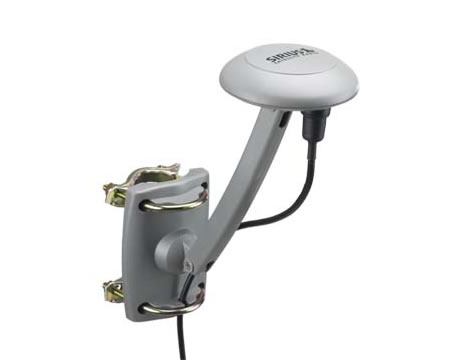
Notes:- This omnidirectional antenna seems to work best when:
- Major effect: the "flat top" of the disk is parallel to the sky
- Minor effect: the "bottom of the Sirius label" painted on the top of the antenna points toward the satellite figure-8 crossover point in Minnesota. I
temporarily mounted my antenna on a pole with the disc parallel to the sky then rotated the pole until I had a rock-solid signal of 10
bars. Depending upon your location in North America (see the AIM THE ANTENNA charts above) you may need to rotate your antenna to a
different location.
CAVEAT: the original three satellites in Analemma orbits are now defunct. All antennas now require an unobstructed view of the southern sky (or be within range of a ground repeater)
- I did not want to drill any holes into the exterior of my residence, so I used two pieces of scrap lumber to manufacture a small wooden "T". The inverted "T" is
lying flat on the roof with the horizontal portion of the "T" (a 24 inch 2-by-4) positioned in the rain gutter. The antenna is fixed to the vertical end of the
inverted "T" (a 36 inch 1-by-2).
- Now I measure 10 bars 100% of the time.
- I live in Canada so one morning in 2014 I noticed the antenna was totally covered with snow. No big deal. I just fastened a 12 inch 1-by-2 to the end of the
inverted "T" so the antenna can poke through the snow. The next summer I hired a professional antenna installer to move it to the side of my chimney.
- This same product in 2012 employs an RG-6 connector and cable
- connector + cable specs for 2006 version (Sirius branding)
- connector + cable specs for 2012 version (SiriusXM branding)
- This omnidirectional antenna seems to work best when:
| Antenna Product |
Description | Antenna Output |
LNA Gain |
LNA Current |
Notes |
|---|---|---|---|---|---|
| SIR3 | Magnetic Roof Mount for Cars | 36 dB | 170 mA |
|
|
| Sirius Indoor-Outdoor (Folding Windowsill) |
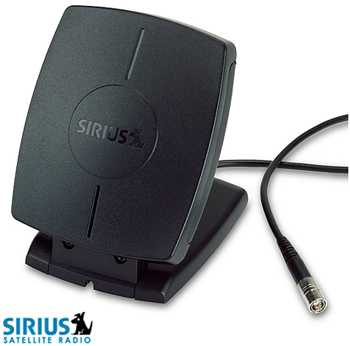 |
36 dB | 170 mA |
|
|
| Sirius XM Universal (previously known as: Sirius Outdoor Home) |
 |
1 dBiC | 42 dB | 160 mA |
|
| SIR4 | Trunk/RV Clip Mount |
36 dB | ? |
|
|
| SIR5 | Marine Antenna | 36 dB | 170 mA |
|
|
| SIR6 | Home | 1 dBiC | 42 dB | 165 mA |
|
| SIR EXT50 | 50-foot Extension | 10 dB | ? |
|
|
| Shakespeare SRA-40 |
Marine | ? | ? |
|
|
| Shakespeare SRA-30 |
Marine | 36.5 dB | 140 mA |
|
|
| STH1 STH1C |
STARMATE Home Kit | n/a | n/a | Contains:
|
|
| SUPH1 SUPH1C |
STARMATE Home Kit | n/a | n/a |
Contains:
|
|
| SIRSP SIR-SP (Splitter) |
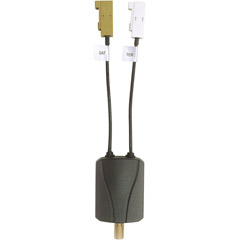 |
n/a | n/a |
|
|
| Combiner / Splitter |
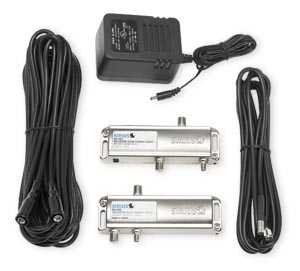 |
n/a | n/a |
|
|
| Pixel Pro-500 Antenna |
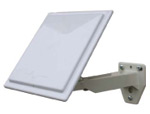 |
12 dBi | 35.5 | ? |
|
| Pixel Pro-600 Antenna |
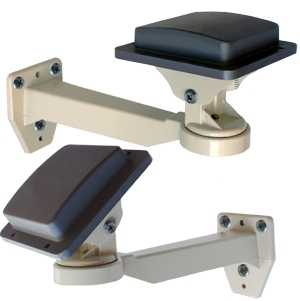 |
8.5 dBi | ? |
|
- So for now it looks like I must operate my STARMATE from a second floor office but I've still got a problem since my stereo is on the first floor. So here are two
possible options:
- enable the "FM transmitter" option on the STARMATE selecting an FM frequency that is relatively quiet in your community, then tune your stereo to the same
spot
- you may need to tack on a single 50 cm (20 inch) wire to the antenna screw of your FM receiver.
- if your STARMATE is located some distance from your stereo -and- your signal is weak, you may need to buy a short external FM transmitter antenna
(these cost about $6.00). In a bind, you can make one by locating an old mono earphone jack from a
1960s transistor radio. Cut off the ear piece then separate the two plastic wires (discard the wire going to the plug sheath which corresponds to ground). The
ideal length is 1.40 meters (55 inches) but 70 cm (27 inches) should work just fine.
Maximum Frequency for FM 107.9 MHz Speed of Light (radio waves) 299,792,458 m/s (vacuum) Speed of Light (radio waves) 299,702,547 m/s (air) Half wave calculation 300/107/2 = 1.40 m (55 in) Quarter wave calculation 300/107/4 = 0.70 m (27 in) - in rarer instances you may not find a quiet location on your FM dial so may need to purchase an external third-party FM
transmitter. (mandatory for college dorms)
- you may need to tack on a single 50 cm (20 inch) wire to the antenna screw of your FM receiver.
- purchase SIR-EXT50 which will add a 50-foot (15 m) extension to your coaxial receiver wire. Since we're using frequencies near 2.32 GHz (2,320 MHz) it is
not wise to rig up a DIY (do-it-yourself) extension unless you've got prior experience in this area. Also, a short circuit on the
receiver antenna line can damage the antenna power supply in your radio.
Common Use of the Radio Frequency Spectrum:Frequency Use Notes 530-1700 KHz AM Radio (note: 1700 KHz = 1.7 MHz)
27 MHz Citizens Band Radio,
Walkie-Talkies, Garage Door Openers, etc.
54-72 MHz
76-88 MHzNTSC (analog) TV - VHF channels 2-4 NTSC (analog) TV - VHF channels 5-6 VHF Band I 88-108 MHz FM Radio VHF Band II 174-216 MHz NTSC (analog) TV - VHF channels 7-13 VHF Band III
470-890 MHz NTSC (analog) TV - UHF channels 14-83
2.320 GHz Sirius + XM radio
2.450 GHz Microwave Ovens
2.4 GHz 802.11 b
802.11 g wireless internet (wi-fi)
2.4 / 5.0 GHz 802.11 n wireless internet (wi-fi)
5.0 GHz 802.11 a wireless internet (wi-fi)
10 GHz 1010 Radar
Satellite TV Services:
10-18 GHz - Ku Band
18-26 GHz - K Band
16-40 GHz - Ka Band (a.k.a. K3 Band)
100 GHz 1011 (microwaves)
- enable the "FM transmitter" option on the STARMATE selecting an FM frequency that is relatively quiet in your community, then tune your stereo to the same
spot
- 2006 "Sirius Outdoor Home" Info:

- Electrical power: 160 ma (supplied by your radio)
- Gain: 42 dB
- Antenna connector: Female SMA (tiny hex cap)
- Cable connector at antenna end: Male SMA (tiny hex cap)
- Cable Type: RG-58 (50 ohms)
- Cable connectors at receiver end: both SMB (required by your radio)
- 2012 "Sirius XM Universal Outdoor Home" Info:

- Electrical power: 160 ma (supplied by your radio)
- Gain: 42 dB
- Antenna connector: Female F-connector
- Cable connector at antenna end: Male F-connector
- Cable Type: RG-6 (75 ohms)
- Cable connector at receiver end: Male F-connector
- Comes with model: SRS-2VB splitter (only install this if you have more than one radios)
- input: one female F-connector
- output: two female F-connectors
- Comes with two RG-174 jumper cables for two radios: male F-connector to SMB
(required by your radio)
Note: you can purchase these jumpers separately for about $10.00 each
- More info about the STARMATE ST1 and ST1C
- this is a sophisticated digital computer that can simultaneously receive signals from 2 of 3 satellites and 1 terrestrial ground station
- buffered audio will play for approximately 7 seconds after removing the antenna connector
- reinstalling the antenna connector will cause audio to return in 2 seconds
- It appears that the STARMATE is always trying to stuff the digital output buffer with time-tagged content from various sources so the listener never (or almost never) experiences a signal loss as happens when driving under a highway overpass.
STARMATE-4 (ST4TK1 / ST4TK1C)
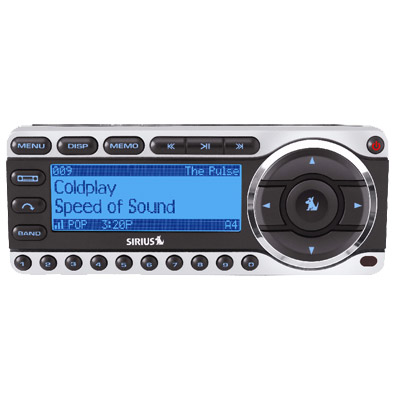
I just added this second radio (for my office) to my Sirius account:
Pros:
- Starting with STARMATE-2, all radios have a single docking port on the bottom so they can be more easily transferred between the vehicle base, home base, or boom box. All cables now mate with the docking base rather than the radio body.
- Larger cool-blue display can be seen at high noon (nerd alert: the display is a special purpose florescent tube; not LED or LCD)
- Signal strength meter now works before activation
- Three rows of ten preset buttons (rather than five rows of six buttons). First press the Dog Button then use the ten buttons to directly enter a channel number. Note that this "random access" functionality was only possible on the STARMATE 1 via the remote control.
- includes a vehicle-base for mounting in your car/boat/RV
- includes a mini (2.5 inch) antenna for the FM transmitter
- I also purchased the optional Plug & Play Home Kit (SUPH1C) and noticed that there is no antenna jack for the FM transmitter on
the home-docking base. The only way to connect it to your home stereo is by the supplied audio cables.
(more on this in the next section labeled FCC Part-15 Devices below) - So I used the power adapter from the Home Kit along with the vehicle-docking base which does have an FM transmitter
antenna jack. The built-in FM transmitter in the STARTMATE-4 is five times weaker than that of the STARTMATE-1 which means that the maximum distance between your
STARTMATE-4 and your FM radio has dropped from 5-m (30-ft) to 2-m (6-ft). This means that the built-in FM transmitter is virtually unusable in urban areas. This change
is by design.
(more on this in the next section labeled FCC Part-15 Devices below) - The only way around this is to use the supplied audio cables to directly connect to a stereo, or purchase a third-party FM radio transmitter (great for college dorms). Click here for a short list: Third-Party Transmitters
- It might make more sense to buy a boom box rather than the Plug & Play Home Kit. The boom box comes with a folding
windowsill antenna, audio cables, and A. C. power adapter.
Caveat 1: Make sure you've got a boom box and eight fresh D-cells for the next power outage. During the Northeast Blackout of 2003, most radio, TV, and cell phone transmitters went offline but the up-link to those Sirius satellites kept on ticking. This might be your only link to the human race.
Caveat 2: In a pinch, you will always be able to power your radio from you car but you'll need a really long power cable to enjoy the radio closer to your fireplace
Using a Sirius Boom Box to survive a residential power loss

Back in 2008 I purchased a Sirius Boom Box for use on the beach in Cancun, Mexico. When I returned from that vacation I continued to use the Boom Box in my home office. I didn't bother removing the eight D-cells (batteries) but did use the supplied AC power adapter.
Now for some reason I don't fully understand, residential power in 2009 is way worse than when I was a kid, and a few 2009 interruptions have averaged an hour. The outage of 2009-July-11 lasted 50 minutes while the 2009-August interruption lasted 5 hours. Whenever it happens you never know if the outage is local, city wide, or across the whole system as happened in 2003 when 55 million were driven into the dark, many for more than 24 hours. In the 2003 case, local radio stations as well as CELL PHONE towers eventually depleted their emergency backup power so even listening to your car AM-FM radio or listening with a portable patio radio wouldn't help. The only thing we can rely on today is that Sirius-XM satellite system orbiting overhead.
Notes:
- When commercial or residential power fails, you've got to unplug the AC adapter from the Boom Box to activate the internal D-cells
- When power has restored, remember to plug in your AC adapter ASAP so that your batteries will not continue to discharge
- Always keep a fresh pack of batteries available for the next "big one"
-
Thinking that fresh rechargeable D-cells may be more environmentally friendly than traditional batteries (and perhaps cheaper in the long run), I decided to purchase a recharger from eBay. Make sure you look for deals because I found this brand new 8-cell model for only $80. The model name is MH-808M and it is capable of simultaneously recharging any combination of 8 cells. AAA, AA, A, C, D.
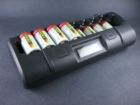 MH-C808M
MH-C808M
- Make sure you are careful when shopping for rechargeable batteries. I saw prices as high as "two for $35" but as low as "eight for $48". The power rating is important as well. They are all 1.5 volts but have different current-over-time specs. For example, I saw low numbers like 2500 mAh (means: "2500 milliamps per hour" -OR- "1 milliamp for 2500 hours") and higher numbers like 10,000 and 12,000. Higher is better.
Sirius Synergi Internet Radio (Canadian)
Sirius Tabletop Internet Radio (American)
| Product Name | Product Number | Notes |
|---|---|---|
| Sirius Synergi Internet Radio | TTR1C | only works with Canadian Sirius accounts |
| Sirius Tabletop Internet Radio SiriusXM Tabletop Internet Radio |
TTR1 | only works with American Sirius accounts |
Specs
- Comes with a remote control (not shown)
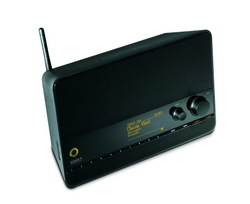
- to ease initial setup
- to change channels or volume from across the room
- Two Front Dials
- Large = VOLUME
- Small = TUNE (Push = menu SELECT)
- Dimensions: 18.50 cm high x 28.25 cm wide (7 1/4 inches high x 11 1/4 inches wide)
- Weight: 2.85 Kg (6.3 pounds)
- A.C. powered (a real A.C. plug, not a junkie-looking wall-wart like you see with computer peripherals)
- requires a high-speed (not dialup) internet connection. Connect via either "Ethernet Cable" or "Wi-Fi"
- Ethernet Cable (old-school internet connection)
- Wi-Fi (good if you've got a Wi-Fi source in your home or office; many people will have one built into their DSL router, cable router, or internet access point)
- works in conjunction with a paid-up active Sirius subscription
- if you already have a radio subscription, then one streaming internet access is already enabled for you at no extra charge
- if you do not have a radio subscription and don't want one, you can still purchase a subscription, use internet streaming now, then add a free satellite radio whenever you change your mind
- Other features:
- Lineout jack allows a connection to a stereo or home theatre
- Headphone jacks on the left-hand side
- When used as a bed-side clock radio:
- two ALARM buttons on the front.
- press the recessed button on the top surface to choose when the radio will auto-shut off (in mostly 15 minute increments) while you drop off to sleep.
- when set to auto, the display will dim when the room light drops (e.g. turning off a lamp)
- This Sirius Internet Radio may solve other problems. Why? Consider this: If you live in a city with no TERRESTRIAL REPEATER (usually communities with a population below one million), then you may have some difficulty using your satellite radio from within an apartment or condo. Condo units where the Satellite Radio Antenna has a direct line-of-sight view to the Sirius satellites (see the first three charts on this page) will have no problems. But if you live on the opposite side of the building, or if your building is in the satellite shadow of a nearby building, you will have problems.
First-time set-up is child's play (and only takes a few minutes):
- Choose "Network Wizard" or "Wired" or "Wireless" from the setup menu
- If Wired: choose DHCP or manual
- If Wireless: input your Wi-Fi security codes (only required if Wi-Fi security is enabled which it usually is not)
- If Wizard: just follow the prompted instructions
- Wait for your unit to go online (it will auto set the clock; you need to set the time zone)
- At this point my unit asked for permission to do a firmware upgrade. I agreed which took 30 seconds.
I'm not sure what was downloaded but the logo in the display changed from Sirius to SiriusXM :-) - Input your Sirius account username and password
- Sit back and enjoy (Big Dial is VOLUME; Small Dial is TUNE; Push the Small Dial to SELECT a menu item)
- Optionally, program your presets
"FCC Part-15 Devices" and the "NAB Report to the FCC"
The NAB (National Association of Broadcasters) is a Washington DC based lobby group attempting to protect the business interests of terrestrial radio and television broadcasters. These businesses were (understandably) upset by competition from next-gen devices like iPods, MP3 Players, and Satellite Radios which are able to rebroadcast the their content to nearby FM radios. In 2006, the NAB commissioned a study of these devices and determined that 85% of them violate what the FCC has labeled "Part 15" devices. On average, the radios produced signals 5 times hotter than the legal limit. The NAB turned over this report to the FCC who, in turn, notified radio manufacturers that they needed to reduce the output power of their FM signals. This is why the Starmate-1 (ST1) FM Transmitter is 5 times hotter than the Starmate-4 (ST4).
| Sirius "Sportster Replay" (old) Notice the built-in FM transmitter antenna (20 gauge wire) which travels around the outside then is soldered to a point on the upper right just beside the silver crystal. |
Sirius "Sportster Replay" (new) Notice that the FM transmitter antenna wire is missing. Also, this is a slightly different circuit board (ignore component color but notice components size and position at lower right) so there could be other differences not visible in this photo like resistor values or firmware parameter settings. I wonder what the red dot on the CPU means? |
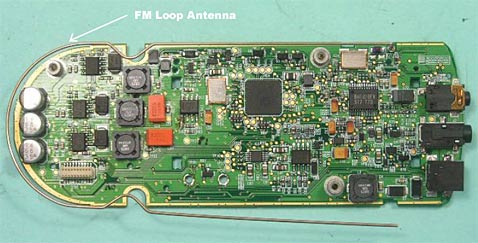 |
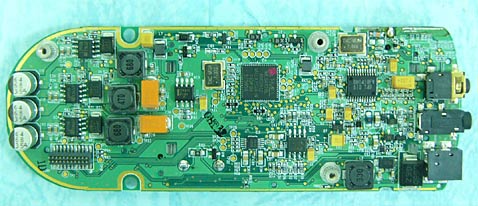 |
So what should you do?
| Location | Possible Solutions |
|---|---|
| Vehicle | Satellite Radio companies and the FCC do not want you driving down the road with an over-powered FM transmitter which could annoy FM listeners in other cars.
|
| Apartment Condo Hotel |
Satellite Radio companies and the FCC do not want you blasting an over-powered FM signal to other near-by radios.
|
| Home | Since it is unlikely that you will radiate a signal over 46 m (150 ft) you can do just about anything you want
|
| College Dorm | Since it is likely that your college buddies will want to listen to your radio, take up a collection then...
|
Third-Party FM Transmitters.
caveat: these widgets seem to have fallen out of favor in 2020 as Bluetooth interfaces become more popular
- Important Notes:
- When considering transmitters outside of the FM band, these are the legal power limits:
Country Power Equivalent USA 025 mW 0.25 Watts Canada 100 mW .100 Watts - But since field strength can be changed by antenna geometry, the FCC regulates the FM band by measuring field strength at a distance of three meters making sure the signal doesn't exceed 250 uV (microvolts) per meter
- Do not be tempted by the lure of illegal high-powered transmitters. The main reason why low-powered models sometimes disappoint is because the volume control driving the transmitter is set too low (which means the carrier wave receives low, or no, modulation). In the STARMATE-1, the internal FM transmitter is modulated by the much larger audio signal connected ahead of the volume control.
- When considering transmitters outside of the FM band, these are the legal power limits:
- www.villa-fm.com
- this HLLY transmitter features a 500mw (0.5 watt) FM transmitter which probably is not legal under FCC Part-15
- features a metal case (will reduce hum and feedback) and digital display
- this website is in Texas but the product is manufactured in China
- www.HllyElectronics.com
- these HLLY transmitters feature transmitter powers of: 0.2W, 0.5W, 1.0W, 5.0W, etc.
- despite the website hype, I don't see how anything over 0.025W is legal under FCC Part-15
- this website is in Texas but the product is manufactured in China
-
www.RamseyElectronics.com/cgi-bin/commerce.exe?preadd=action&key=FM25B
- The FM25B features a 25mW transmitter and is FCC Part-15 Compliant
- Supports all even and odd frequencies from 88.1 to 107.9 MHz via 12 DIP switches
- I own this product and can tell you that it makes the useful distance of a Starmate-4 equal to that of a Starmate-1

- this is a kit requiring soldering skills.
- Manual without schematic:
http://www.ramseyelectronics.com/downloads/manuals/Fm25B.pdf
(the paper manual inside the kit does contain a complete schematic on page 34) - Since Heathkit is now just an educational products company, it is nice to know that some companies still sell kits just for the fun of doing-it-yourself. Do any of you hardware hackers from the 1960s remember building a Heathkit Color TV, signal generator, oscilloscope, or Heathkit H8 Computer?
- Some companies (like HobbyTron on the next hyperlink) are selling preassembled units. Many smaller proprietors are selling preassembled transmitters on eBay.
- Manual without schematic:
http://www.ramseyelectronics.com/downloads/manuals/Fm25B.pdf
- www.RamseyElectronics.com/hk/default.asp?page=amfm - more AM and FM kits
- www.HobbyTron.com/LowPowerFMTransmitters.html
- The FM25B features a 25mW transmitter and is FCC Part-15 Compliant
- Supports all even and odd frequencies from 88.1 to 107.9 MHz via 12-DIP switches
- this is not a kit

- www.electronics-diy.com (Do It Yourself)
- lots of kits and plans
- links to other locations if you don't want to build a transmitter from scratch
- www.nrgkits.com
- this is a radio kit supplier located in Bradford, United Kingdom.
(Visit their website to hear a very enticing background audio)
- this is a radio kit supplier located in Bradford, United Kingdom.
- www.MobileBlackBox.com - V6000 FM Transmitter
- is FCC Part-15 Compliant
- can be used in a car or house
- features a cool looking LCD display
- www.ccrane.com/radios/fm-transmitters/fm-transmitter.aspx
- is FCC Part-15 Compliant
- can be used in a car or house
- features a cool looking LCD display
- www.WholeHouseFmTransmitter.com - Whole House Transmitter
- is FCC Part-15 Compliant
- can be used in a car or house
- only supports six FM frequencies from 106.7 MHz to 107.9 MHz which are set by 3-DIP switches
Using "Sirius Satellite Radio" in Cancun, Mexico. (2006)
(click here for the much shorter text associated with my 2008 visit)
I just returned from a vacation on the Mayan Riviera (Playa del Carmen) with my wife and our Sirius "STARMATE STC1 radio". We brought along the radio as an alternative to late-night and early-morning TV viewing but ended up using it 90% of the time. Here are some amusing things that happened to me and hopefully will help you.
- Applying power
- You should not see 220 volt receptacles in Mexico but since the power supply that came with my "STARMATE Home Kit" is rated for an input range of "110 to 240 Volts AC", you probably do not need to worry about a blow out.
-
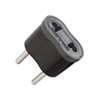 Even though Mexican power in Cancun is 110 volts AC, many of the hotels are wired
with the European-style wall sockets (plugs require "two round electrodes" rather than "two flat electrodes" which is standard in Canada and the USA). Fortunately,
I had purchased a flat-to-round adapter from "The Source by Circuit City" for $10.00 before we
left Canada. Here is their online catalog information should you decide to do the same:
Even though Mexican power in Cancun is 110 volts AC, many of the hotels are wired
with the European-style wall sockets (plugs require "two round electrodes" rather than "two flat electrodes" which is standard in Canada and the USA). Fortunately,
I had purchased a flat-to-round adapter from "The Source by Circuit City" for $10.00 before we
left Canada. Here is their online catalog information should you decide to do the same:
FOREIGN TRAVEL ADAPTER - CONTINENTAL EUROPE - 2738027 Note that Radio Shack sells the same product at the same price but with Catalog Number: 273-1447 - Note: Some hotel sockets will accept both round and flat electrodes but are recessed into a pocket which is too small to physically accept the already-small power adapter (could this be a hotel safety precaution?). You will need some kind of mechanical extension to get around this so it is a good idea to pay the 10 bucks and be better prepared
- Connecting the antenna
- We were placed in suite with a beautiful view of the Caribbean sea (click
here to see the location). Unfortunately this "East by South East" view only allows our antenna to "see" one satellite at a time, and then only when it is
approaching Mexico from South America (see the animated satellite map above for details). It was the worst possible satellite-radio location since Sirius
instructions said we should be pointing the antenna to the North-West. Using a cheap "Sirius Indoor-Outdoor antenna" I was not able to detect any signal from the
balcony of our suite. However, there were at least two other options immediately available:
- The top of a palm tree was parallel to our balcony railing and was only 3 m (10 ft) away. The "Sirius Indoor-Outdoor antenna" comes with a 6 m (20 ft) cable and I knew I could probably throw the antenna module into the tree and have at least 3 m (10 ft) remaining to get inside the room. I didn't want to annoy anyone with my antics at this time so I decided to keep the "palm tree option" as my option of last resort.
- We also happened to be located on the top floor of a 3 floor resort with a stone-tile-roof overhang (if this tile was laid over a metal base than this was
probably part of my reception problem). I flipped the antenna up onto the stone-tile-overhang and a solid signal immediately snapped in. I left the antenna on
the tile roof for the next 7 days and the plastic never melted despite maximum air temperatures of 33 C (92 F) and direct sunlight.
Humorous postscript: prior to our Saturday check out, I discovered that the antenna wire was snagged between two pieces of stone-tiles. I didn't want to take the chance of either breaking the wire or loosening a tile so I borrowed a broom from the maid and had the wire un-snagged in less than 2 seconds.
- We were placed in suite with a beautiful view of the Caribbean sea (click
here to see the location). Unfortunately this "East by South East" view only allows our antenna to "see" one satellite at a time, and then only when it is
approaching Mexico from South America (see the animated satellite map above for details). It was the worst possible satellite-radio location since Sirius
instructions said we should be pointing the antenna to the North-West. Using a cheap "Sirius Indoor-Outdoor antenna" I was not able to detect any signal from the
balcony of our suite. However, there were at least two other options immediately available:
- External Speaker Required :-)
- I had mistakenly assumed that each room would be equipped with an FM Radio through which I could play my STARMATE-1 (which everyone knows was designed for use
inside an automobile, truck, or RV). Well, there was no in-room radio, and we didn't bring one along, so there were only three options remaining:
- only use headphones (not cool when sharing a room with another person)
- purchase a cheap FM radio for use in the room (we arrived late so I couldn't try this immediately)
- use the TV (this procedure is for techies only)
- remembering that the video portion of NTSC television employs AM (amplitude modulation) while the audio portion of television employs FM (frequency modulation), all I needed to do was get the Sirius signal into the TV.
- also remembering that a mid-band gap exists between channel 6 and 7 (channel 6 ends with 88 MHz while channel 7 starts with 174 MHz) I realized that
channel 6 would be my only hope.
For Techies Only: Most techies already know that the video (AM) portion of channel 6 starts at 80 MHz while the audio (FM) portion ends closer to 88 MHz. Also, there is a lot of slack engineered into these analog tuners so we should be able to directly use the Sirius signal without resorting to using some harmonic approach to get these lower frequencies into the higher TV channel. - this newer style TV did not have a tuner but was sitting on a thin plastic hardware base connected to a LodgeNet free/pay-per-view hotel system. Since the "remote control" changes the channel of the LodgeNet black box, I needed to run a wire from the antenna jack of my STARMATE-1 directly to the input of the LodgeNet and then use the remote control to set the channel to 6. If you can't see what you are doing then just locate the coaxial cable coming from the wall and disconnect it.
- I had brought a home-made dipole antenna which is nothing more than two 1.5 m (5 ft) wires connected to an old 3/16 inch earphone plug. I broke off one of the wires to extend the other one so it would conveniently reach the LodgeNet black box.
- I set the "FM Transmitter Frequency" of the STARMATE to 88.1 MHz, turned on the TV then changed the channel to 6 (you need to do this every time you power-up the TV). Bingo! Sirius radio playing through the TV.
- Note: this is going to be too much of a pain every time so we'll definitely take a portable FM radio with us on our next trip.
- I had mistakenly assumed that each room would be equipped with an FM Radio through which I could play my STARMATE-1 (which everyone knows was designed for use
inside an automobile, truck, or RV). Well, there was no in-room radio, and we didn't bring one along, so there were only three options remaining:
- Enjoying the Signals
- now we had daily access to our favorite channels:
CBC Radio One, BBC World Service, NPR Now, BBC Radio 1, Howard-100, Bubba
I'll go mental if I don't hear "Quirks and Quarks" on CBC or "Science Friday" on NPR
- now we had daily access to our favorite channels:
- Summary
- avoid all this audio-output hassle by making sure you take an FM Radio with you
- alternatively, travel with a cheap set of computer speakers. All STARMATE radios can drive PC speakers directly from the AUDIO OUT Jack.
- ask the hotel for a room with a balcony opening to the North (or North-East), or a top floor, or both. For other locations, check the animated map above.
- buy a portable Sirius boom-box for the balcony or beach
Using "Sirius Satellite Radio" in Cancun, Mexico. (2008)
I just returned from a vacation on the Mayan Riviera (Playa del Carmen) with my wife and our Sirius "STARMATE ST4 radio". We brought along the radio as an alternative to late-night and early-morning TV viewing but ended up using it 90% of the time.
- General Use
- This time I was better prepared and so brought along a Sirius boom box (purchased online for half price) for use on the beach (the STARMATE ST4 just docks in a little receptacle).
- The boom box can be powered by eight batteries (D-cells) or domestic power in the range of 110-220 Volts AC
- Bring along headphones if you don't want to disturb others.
- The TV in our room had audio jacks in the front so we could play the STARMATE through the TV or just use the Boom Box.
- Connecting the antenna
- Same as before, I just through the window-sill antenna onto the roof for a constant 7-bars signal. I brought along a second antenna for the boom box.
- Same as before, I just through the window-sill antenna onto the roof for a constant 7-bars signal. I brought along a second antenna for the boom box.
- Enjoying the Signals
- It was raining after the Saturday afternoon check-in so we listened to Randy Bachman's "Vinyl Tap" on CBC Radio One
- Six day later I didn't miss "Science Friday" on NPR Now. I wonder if they realize that people hear their program on the beach.
Using "Sirius Satellite Radio" in Toronto, Canada. (2008)
Great news for Toronto subscribers. For the past week I was driving around downtown Toronto and never experienced a single signal interruption. I stayed in an East-facing hotel room (supposedly the worst possible location for Ontario subscribers) and everything worked perfectly. Switching to my SIGNAL STRENGTH display revealed a whopping 10 bars of TERRESTRIAL signal. On Friday night I drove from downtown Toronto back to Kitchener with my display sitting on SIGNAL STRENGTH. Here is a list of my signal readings:
| Location | Terrestrial Signal | Satellite Signal |
|---|---|---|
| Young Street and College Street | 10 bars 3 | intermittent |
| Young Street and Gardiner Expressway | 10 bars 3 | intermittent |
| Gardiner Expressway and Islington Avenue | 6 bars 1 | 10 bars 3 |
| Gardiner Expressway and Highway 407 | 10 bars | 10 bars 3 |
| Highway 407 and Highway 5 | 6 bars 1 | 10 bars 3 |
| Highway 407 and Highway 401 | 10 bars | 10 bars 3 |
| Highway 401 by the Toronto Airport | 3 bars 1 | 10 bars 3 |
| Highway 401 and Highway 410 (Brampton/Mississauga) | 10 bars | 10 bars 3 |
| Highway 401 and Winston Churchill Blvd | 6 bars 2 | 10 bars 3 |
| Highway 401 and Highway 407 | 6 bars 2 | 10 bars 3 |
| Highway 401 and Highway 25 (Milton) | 3 bars 2 | 10 bars 3 |
| Highway 401 and Kelso Park | 0 bars | 10 bars 3 |
Superscripts:
- These are low-lying areas and I am guessing that the Sirius terrestrial repeater is sitting on top of the C. N. Tower (near the intersection of John St. and Front St. in Toronto)
- Out this far, the terrestrial signal always increased whenever I was under an overpass. Since I never noticed any hardware mounted under the overpass, I am assuming that the concrete walls were acting as a terrestrial radio reflector/collector.
- During this driving experiment I always has access to usable TERRESTRIAL or SATELLITE signals, and the radio seamlessly switched from source-to-source. The only real-world compliant I noticed was caused when I passed the odd 18-wheeler. Some of these truckers were using powerful third-party FM transmitters (while I was only using the transmitter built into my STARMATE 1) which meant I would get a 10 second blast of country music while I passed them. One way to get around this is to purchase one of the direct connect solutions or a more powerful third-party FM transmitter.
Using "Sirius Satellite Radio" in Cancun, Mexico (2010)
-
The bad news is that we could only get a west-facing room. This means that our radio only worked for 4 out of every 8 hours (see the animated map at the top of the page).
-
The good news is that my radio worked 100% of the time on the beach.
Satellite Radio Companies
- Europe + Africa + Asia + Central America + South America
- WorldSpace @ Wikipedia
- 1.467 - 1.492 GHz (L Band)
- WorldSpace @ Wikipedia
- Western Hemisphere Only
- SIRIUS Satellite Radio @ Wikipedia
- 2.3200 - 2.3325 GHz (S Band)
- 4 MHz wide band (Satellite)
- 100 channels spread across 1000 frequencies
- 4 MHz wide band (Ground Repeater)
- 100 channels spread across 1000 frequencies
- 4 MHz wide band (Satellite)
- 100 channels spread across 1000 frequencies
- 4 MHz wide band (Satellite)
- 2.3200 - 2.3325 GHz (S Band)
- XM Satellite Radio @ Wikipedia
- 2.3325 - 2.3450 GHz (S Band)
- 4 MHz wide band (Satellite)
- 4 MHz wide band (Ground Repeater)
- 4 MHz wide band (Satellite)
- 2.3325 - 2.3450 GHz (S Band)
- For a little more technical information please refer to Page 84 of the February-2006 issue of Scientific American
Partial Excerpt:Working Knowledge: Song Beams; February 2007; Scientific American Magazine; by Mark Fischetti; Satellite radio can send the same 100 channels of music, talk and sports to you at any street corner in the nation. Yet someone next to you may receive a different set of channels, and a third person who does not subscribe cannot pick up a thing. How can the service blanket the country yet be so discriminating? Three companies provide the world's satellite radio: XM Satellite Radio and Sirius Satellite Radio for the U.S.; and WorldSpace for Africa, Asia, and Europe. XM uses two geostationary satellites and about 800 low-power ground repeaters scattered around cities where tall structures can block the satellites' line of sight [see upper illustration]. Sirius has three birds in highly inclined, elliptical orbits and about 100 high-power repeaters, each bathing a metropolitan area. Both architectures provide equally reliable service, says Dan Goebel, a senior research scientist at the Jet Propulsion Laboratory in Pasadena, Calif., who previously designed amplifiers for ground repeaters.
- SIRIUS Satellite Radio @ Wikipedia
Unofficial History of Sirius + XM
| 1988 |
|
| 1990 |
|
| 1991 |
|
| 1992 |
|
| 1997 |
|
| 1999 |
|
| 2000 |
|
| 2001 |
|
| 2002 |
|
| 2006 |
|
| 2007 |
|
| 2008 |
|
| 2009 |
|
| 2010 |
|
I'm not sure why people bother to steal them
- These radios are part of a subscription service.
- You pay (subscribe) to have the content delivered to them.
- Once stolen, the original owner will:
- report the radio stolen to police so the owner can collect insurance
- report the radio stolen to Sirius so the subscription can be cancelled or moved to a replacement device. Either action will render the stolen radio useless.
- Starting a subscription with a stolen radio will immediately flag the black-market customer as an owner of stolen property. An investigation will lead back to the thief
Satellite Radios
- Like Satellite TV, every Satellite radio has its own unique ID
- Sirius calls their number "SID" (Sirius Identification number)
- The SID is associated with your account during the subscription process.
- When your account is started, Sirius will continually broadcast ENABLE signals to a pool of just enabled SIDs. This signal will allow the radio to operate as designed
- When your account expires, Sirius will continually broadcast DISABLE signals which will block every subscription channel except for the local weather channel (this same channel is the only one enabled after a hard reset)
- If someone steals your satellite radio:
- Contact Sirius and report it stolen
- Sirius will send out DISABLE messages for years (they have a complete private channel to do this)
- The same thing happens when you allow your subscription to expire
- You would need to do this anyway if you wanted to enable a replacement radio
- When the thief sells the satellite radio to an unsuspecting third party, the third party will need to report the SID to Sirius to start a new subscription. That is when Sirius will tell the customer that the radio is stolen.
Internet Ratios
- Internet radios need to log onto the Sirius Streaming website using your Sirius account name and password
- If someone steals your internet radio:
- log onto your Sirius account and change the password ASAP. This will disable the internet radio immediately.
- Now contact Sirius and report it stolen
- Every time it had previously connected to Sirius using your account name, it would have also reported its associated SID (Sirius Identification number)
- When the thief sells the internet radio to an unsuspecting third party, the third party will need to input their own SIRIUS username and password to start it working. When the radio connects to the Sirius server, the new customer's I/P address (internet address) will be visible to the people at Sirius. Since the radio is stolen, the I/P address is passed over to the police who are now able to use ISP (internet service provider) records to trace it back to the third party customer. The police will visit the customer who would be pressured to tell the police where they bought the radio.
Marketing Controversies
Before the merger of Sirius and XM, both companies competed in both the US and Canada. Competition brought with it competitive pricing and improved content. Since the merger, SiriusXM in both the US and Canada (where the US company owns 35% of the Canadian company) have become monopolies in their respective countries and this has led to higher prices, automatic renewals (without notification), and lower customer service. No surprise that consumers are now complaining to their respective governments.
- Customer (2014)
- http://www.cbsnews.com/news/sirius-xm-to-pay-3-8-million-to-settle-with-45-states/
-
http://siriusbuzz.com/siriusxm-settles-over-automatic-renewal-pays-3-8-million.php
- comment: automatic renewals are still happening in Canada as of September-2015
- Artist (2015)
Remember that all this is going on while billions are being allocated for a corporate stock-buy-back
It appears that SiriusXM in both countries seem to be ignoring the free streaming services offered by most radio stations. While streaming will not affect customers using mobile radios it will impact customers using radios in offices and residences where broadband internet is ubiquitous
Terrestrial Repeaters
2016-05-17
- I noticed that the Starmate-4 in my office in downtown Kitchener was still working even though the antenna wire had popped out. A quick check with the SIGNAL
INDICATOR under the primary MENU showed that I was connected to a TERRESTRIAL REPEATER with 10-bars
- Walking around downtown Kitchener with a Starmate-4 docked in a Sirius Boom Box (no antenna attached) leads me to believe that the repeater might be sitting on top of the old Canada Trust building at: 305 King Street West, Kitchener, Ontario
- Driving West with a Starmate-4 docked in a Sirius Boom Box
1 km TER = 10 bars (now my antenna connector must be attached; just using the cheap Sirius Indoor-Outdoor antenna) 2 km TER = 10 bars 3 km TER = 6 bars 4 km TER = 3 bars - Ground Repeater info
- http://www.dogstarradio.com/sirius_map.php (Canadian cities visible on Northern US States)
- http://www.digitalhome.ca/forum/87-siriusxm-satellite-radio/119282-list-sirius-xm-repeaters-canada.html
- Here is a link or two about what is going on
Internal FM modulator is disabled?
I was preparing for a party on 2016-08-15 where my Starmate 4 would be sending output to a nearby stereo tuner (this was one of those situations where I needed background music in a room with no access to my Sirius external antenna). That is when I noticed that the "FM Transmitter" option is missing from the main menu when the Starmate 4 is docked in a Boom Box. Thankfully my Ramsey FM modulator served me well (I used an audio cable to connect the modulator to my Boom Box)
Weird antenna problem (2022) SOLVED!

- For the past months my signal has been fading in and out with the signal strength meter on the radio only showing three bars.
- I first thought the outdoor antenna might not have survived the polar vortexes seen in southern Canada this year with daily temperatures almost always making it down to -25C (-13F for you Yanks).
- Today was sunny so got out an aluminum extension ladder to swap out the antenna disk (pod-like thingy). This did not work
- Closer examination of the RG-6 connector showed that a tiny bit of the co-axial braid was exposed and discolored (so possibly oxidized)
- At this point you have two options:
- replace the whole cable with factory terminated ends (safest)
- replace the external connector if you know how (DANGER - the radio powers a small amplifier in the antenna so DO NOT CUT OFF the old connector until you have disconnected the radio).
- Anyway, I am back to 10 bars (will intermittently drop to 7 then immediately bounce back to 10)
- Note: "RG" = Radio Guide Comment: using RG-174 to connect your boombox to RG-6 should result in an impedance mismatch. So I am uncertain as to why they did not provide a little inline transformer to match the impedance.
Ontario Wind Storm (2022)
- A huge windstorm blew through southern Ontario today any now my Sirius Outdoor Home antenna is missing so I had to purchase a replacement.
- This year I noticed that the trees behind my place (southern exposure) have grown high enough, and close enough, that reception is no longer 100% after the leaves pop in the spring (not a 100% unobstructed view of the sky) so I decided I needed to move my antenna to a higher location.
- So I purchased a Philips J-mount (SDW-1220/27) from Amazon for $30.
- It is easy to install in wood
- It is harder to install in brick:
- so make sure you have got the tools, skills, and experience to drill 4 small holes into the brick (never the mortar) which will enable you to insert 4 plastic anchors (not provided) for the mounting bracket.
- if you do not have the tools, skills or experience then call someone who does.
- This might cost you 50-100 dollars which is 10 times less that the cost to have someone replace a cracked brick.
- Do not ignore a cracked brick or loose mortar. Thermal expansion and contraction will eventually cause the problem to grow until failure.
- if you install the J-mount on a chimney then remember that hot gases rise. You do not want the plastic antenna pod, or plastic cable, exposed to high temperature gases so the antenna pod must always be positioned below the chimney top.
- final thought: if you lost your antenna then considering listening to SiriusXM over the internet
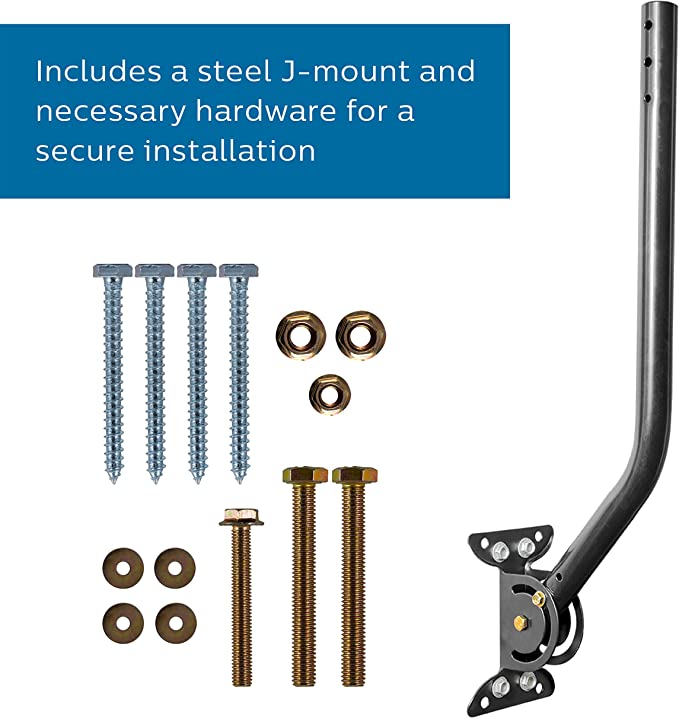

 Back to Home
Back to Home